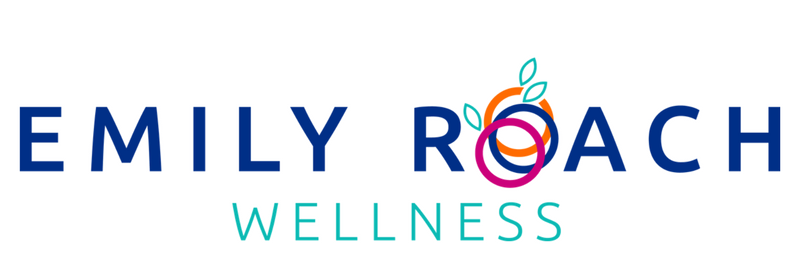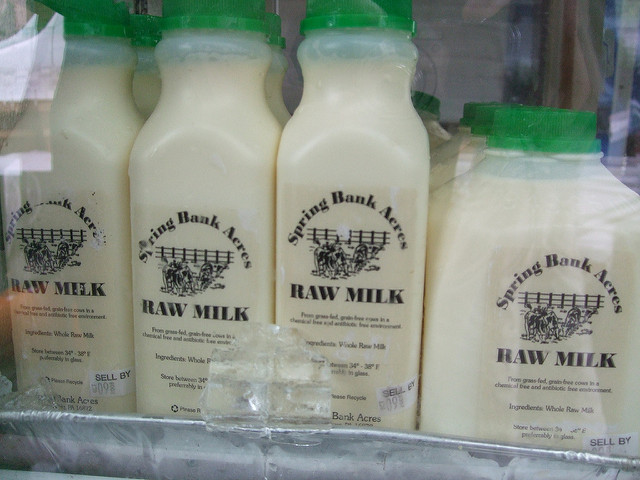How an autoimmune diagnosis, eating disorder, and stress led to my career as a health coach.

This is my story of how an autoimmune disease and an eating disorder all led to my career change into health coaching.
How did I get here talking about health and nutrition to all of you? It was a bumpy road, with an autoimmune disease that kicked things off. I think it’s worth explaining why I’m so passionate about helping women feel their best, and why I put the effort in to take care of myself.
Autoimmune Disease
For me, my health journey starts when I was three years old and I was diagnosed with an autoimmune disease. I was one of the first patients in the my city develop Kawasaki’s syndrome. My tiny body swelled up, I couldn’t walk, color, and play like a normal three year old. It’s like an inflammation nightmare. It affects lymph nodes, skin, and potentially coronary arteries.
I went on an aspirin therapy regimen, and remained in bed till my body healed. I blocked out that memory for many years, but it came back when I was in late elementary school. I was followed by cardiologists for years to assess the possible cardiac damage caused by this autoimmune disease.
Things were quiet for awhile until I was diagnosed with an irregular, irregular heartbeat. That led to more tests, a diagnosis of mitral-valve prolapse, and a prescription for beta-blockers. This was at the beginning of middle school. Not an awesome time in anyone’s life, but feeling “different” was even tougher at this age. I wore heart monitors to class on occasion, and worked really hard to hide it.
I just didn’t feel good.
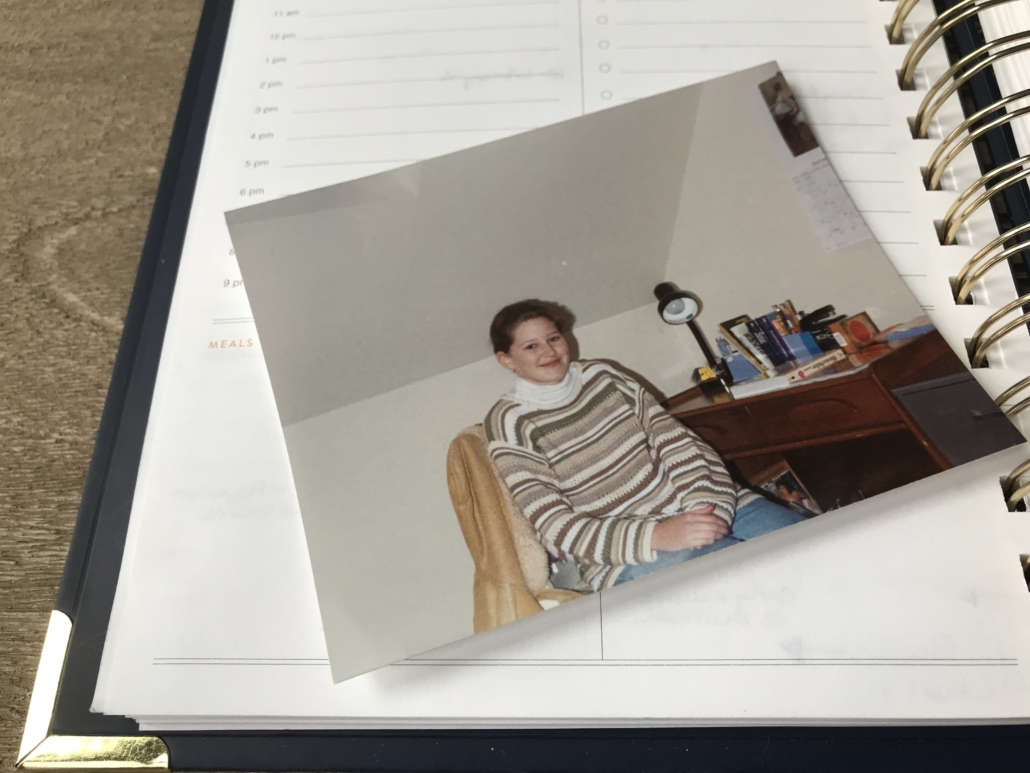
This when I felt my worst in middle school.
The beta-blockers left me feeling lethargic, despite always being athletic in the past. I was tested for fibromyalgia, which was very new at the time, and was inconclusive. As someone who loved playing tennis, swimming, and playing outside, I felt like I lost a part of me.
Over time, the beta-blockers caused horrible reflux which led me to see a gastroenterologist. Digestive issues are near and dear to my heart as I’ve been there too. I tried all the anti-reflux pills, drinks, and tablets I could find. Nothing worked. Yet no one asked what I was eating.
Eating Disorder
How did I handle that horrible feeling of reflux? Not very well. I binge ate to try to quiet the fire in my stomach. It didn’t matter what the food was, ice cream, cookies, crackers, you name it. This is when disordered eating arrived in my life. I was fifteen years old.
I started to binge and purge, thinking it would help make the reflux feelings go away. I was secretive, and clearly not in the right mindset to handle the health struggle I was dealing with.
I will forever be grateful to my mother who discovered my behavior before it went too far. As a nurse, she was pretty quick to figure out something was really off. She connected me with an eating disorder therapist who helped me learn how to have a healthy relationship with food. It took a long time to stop the urge that had become a habit everyday after school for weeks.
Misdiagnosis
My bumpy health journey doesn’t end there. I went on to get diagnosed for chosto-chondritis, which is a form of arthritis in the chest wall. The chest pain I felt for years was real, but it had nothing to do with my heart. The heart condition was a misdiagnosis, and those prescriptive pills did nothing for me but wreck my energy and confidence during those high school years. No one should have to deal with that.
With the change in medication, I felt like the weight was lifted off my chest. Literally. I complained for years of stabbing chest pain, or feeling like a brick was on my check.
Fast forward a few years and I graduated college, got married, and became pregnant. Suddenly, I couldn’t take my arthritis medicine anymore in the third trimester. I stressed. How would my body handle the pain again?
Motherhood
It was becoming a mother which really opened up my eyes to what happened to our food over the past few decades. I started reading ingredient lists, switched to organic milk, and began to make wholesome meals like the ones I grew up with. No more cheese and crackers with wine for dinner.
That medicine I was so worried about needing? I never needed it again after having my daughter and changing the way I was eating. But it wasn’t easy.
I went back to work when my daughter was just three months old and had to learn how to make dinners fast. The mad rush to leave the office, drive 40 minutes to daycare, and race home to get dinner on the table was a real struggle. There were some cereal for dinner nights and I knew there had to be a better way.
Meal Planning
What changed my confidence in the kitchen is learning how to meal plan. When I started to take the time to develop a balanced meal plan, dinner became an enjoyable experience again. I started planning slow cooker dinners, 10 minutes dinner, and even created some freezer meals.
I started this blog in 2009 to document how we were changing our lifestyle to a healthy, real food based approach. It felt good to share what was working, and I found such stress-relief in the kitchen.
However, a few years ago I struggled with a post-baby body and bad habits of too much coffee and wine. On top of caring for three little ones, we had to move out of the country for my husband’s job. Caffeine and wine became a part of a coping strategy. Those first six months of living away from home were a challenge.
It was time to make a change.
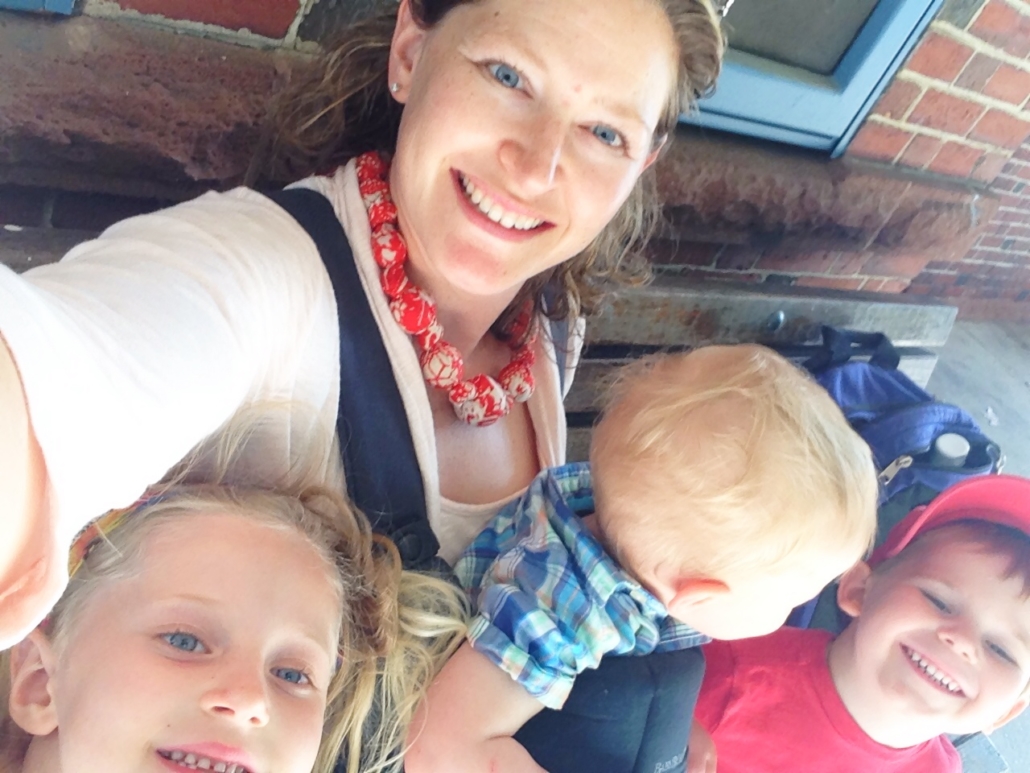
All these babies! Love this time, but I didn’t understand what my body needed to thrive.
Creating a new path
At the library, I started diving into nutrition books. I upped my exercise game. I cut back on the wine Monday-Friday (wait, Thursday) Things started to come together again.
I decided to go back to school to become a culinary nutrition expert at The Academy of Culinary Nutrition. I cooked new foods, immersed myself in modern nutrition, and unlearned the old ways of approaching our diet. I thought I was eating healthy buying whole-wheat pasta and bread, and organic milk. Oh my, I was so far off the mark.
Changing the way I ate dramatically improved my energy level. I think it improved my mood too. The winter doesn’t bother me as much anymore, and I have a better understanding of why our body needs so much Vitamin D. I started playing tennis competitively again after 15 years. Knee pain I had struggled with for years went away, even as I exercised more. Oh, and I dropped 20 pounds. Without dieting. Our bodies work really well when we fuel it with the right foods, and eliminate the stuff that slows us down. This is what I have learned.
All of my success comes from eating the right foods.
Once you have one autoimmune disease, you are much more likely to develop another. I also have a very strong family history of autoimmune disease, which also puts me at an elevated risk. On the test I give my clients, I would have scored over 100+ points before I focused on a holistic lifestyle. Now I can say I’m below 60, but the family connection and previous diagnosis will always put me at risk.
The most important thing, I feel amazing.
I choose to follow a healing diet because I don’t want to go to that dark place again with unanswered health questions. The one thing we can control is our nutrition and lifestyle. I can say for sure it make a difference. Putting the effort in to eat well helps me be a better wife and mother.

I’ve chosen to take control of my health and I thought you all deserve to understand where I’m coming from when I give you guidance and support. Today I still face the same struggles of stress, juggling parenthood, and finding time to do all.the.things. It’s my understanding of how to take care of myself that keeps me going. One day at a time.
You deserve the education to empower yourself to take control of your own health. Today I work with clients who need the extra support and the motivation to make lasting change. I’m proof that you can come back from a health struggle and overcome obstacles.
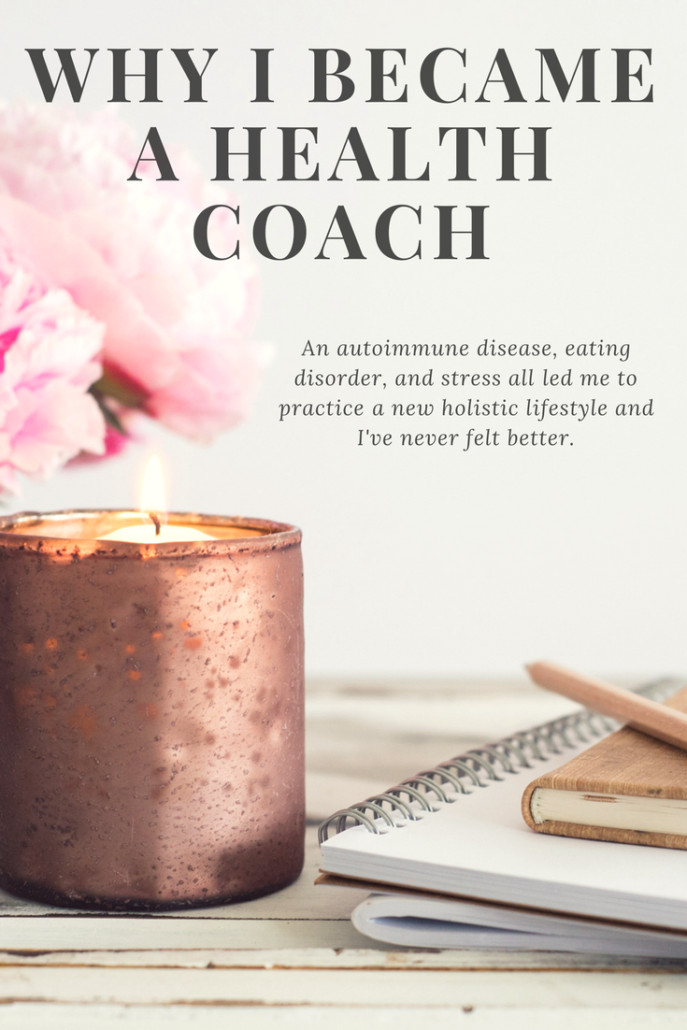
If you shop the grocery store lately, you are bound to have lots of questions about healthy dairy options. There is a giant wall of choices, and you need to understand the differences between conventional, organic, grass-fed, low-fat, fresh, and raw milk. It’s a hot topic in the nutrition field and I’m going to break it down for you.

What are the health benefits of dairy?
Milk and dairy products have been around a very long time, at least 10,000 years or more by most accounts. Fresh milk provides the following nutrients when it hasn’t been altered by pasteurization:
- fat-soluble vitamins like calcium and phosphate
- conjugated linoleic acid (an anti-inflammatory and healing fat)
- balanced amounts of essential fatty acids Omega-3 and Omega-6
- probiotics
- complete proteins, including glutathione (another anti-inflammtory)
Feeding our babies breastmilk provides all of the nutrients above, plus natural growth hormones. We are nearly all born with the ability to process lactose, the sugar in milk, but that ability begins to decrease by age 2. About 25% of Caucasians are lactose intolerant, and 97% of Native Americans are lactose-intolerant. (1) Despite our lactose intolerance issues, dairy is still recommended for children and adults.

Do we need milk for calcium?
While calcium is one of the beneficial nutrients from dairy, it’s not as readily available as the dairy businesses would like us to think. Calcium is delivered into your bones when there is a synergistic relationship between it and magnesium, vitamin K2, and vitamin D. The vitamin D added to milk after pasteurization is not well absorbed by our body. What we really want is calcium in a bioavailable form, which is found in dark leafy greens, sesame seeds, dried figs, rhubarb, and bone broth.
The second big issue with the calcium conversation is the low-fat/no-fat nonsense. If your body is in balance with the other micronutrients I mentioned, calcium needs saturated fat to be absorbed. If you eat a 0% fat yogurt, you just got zero of the calcium.
When the beneficial fat is removed from the milk, it’s replaced with carbohydrate-based fillers like cellulose, maltodextrins, gums, starches, fiber, and polydextrose. The other thing added to low-fat products is SUGAR. When you remove the fat, you remove the flavor. Added sugar is a whole other conversation, but worth noting so you skip those fruity, sugary, no-fat choices next time you are in the yogurt aisle.
Also, studies have shown there is no reduced risk for osteoporosis when drinking two or more glasses of milk a day versus two glasses per week. (2) You are better off protecting your bones by eating a plant-rich diet and incorporating movement into your lifestyle.
What’s the downside of dairy?
Conventional dairy products typically cause your body to go into a proinflammatory state. It can cause leaky gut syndrome, insulin resistance, and development of gut dysbiosis. The main goal I have when creating a healing diet is to reduce the overall inflammation levels in your body. In this day and age, our bodies are taxed by environmental toxins all the time. We can’t always control that, but we can control what we choose to eat.
As someone who creates healing diets for clients, often I work with people to eliminate dairy from their diet. Why? Eliminating dairy gives you the opportunity to see if you can reduce issues related to digestion, skin (acne/rosacea/eczema), asthma, candida, joint pain, allergies, and headaches. When you reduce overall gut irritation, you actually make it possible for your body to absorb nutrients better from the other foods you eat.
Organic versus conventional dairy?
Milk quality has improved in recent years as companies realize customers do not want antibiotics in the glass of milk they serve their kids. However, if you do not choose organic milk, you will be exposed to pesticides. They exist in the grains fed to the cows, which then goes right into the milk. The toxins actually bind with the fat in milk and they are not eliminated by pasteurization. Always purchase organic milk to avoid the toxic exposure. Remember, this applies to all your dairy products: ice cream, cream cheese, cheese, sour cream, creamer, and so on. The conventional milk used for these products is pro-inflammatory which is exactly what I teach my clients to avoid.
What happens when milk is pasteurized?
Pasteurization is the process of heating milk to very high temperatures to kill off any bacteria, or microbes, present. It came into practice in the 1800s when we didn’t have the clean facilities to gather milk on a regular basis. The demand was increasing during the time of industrialization and pasteurization allows for milk to be produced cheaply, which is what the big dairy businesses needed. Homogenized milk was the next change, where milk fat is separated so the cream no longer rises to the top. So what does this do to our milk?
Pasteurized milk has no live bacteria, compared to raw milk that may have lactobacilli present. You know, those probiotics you pay for in a bottle used to come from a glass of milk. Heat from pasteurization breaks down the proteins and fat, resulting in health-damaging consequences. The new milk creates a milk-fat soap through saponification. This creates a product that irritates your gut and can cause either diarrhea or constipation. The nutrients we want from milk, like calcium and phosphate, are now much less bioavailable and difficult to absorb. It’s about a 6-fold drop in nutrition when comparing fresh milk to pasteurized milk. (3) The amino acids are damaged with the heat and then turned into pro-inflammatory irritants, or allergens.
Where can I get healthy dairy options?
Yogurt is still the one dairy option I recommend keeping in your diet, if you are able to tolerate it. The good news is that fermentation rejuvenates the damaged proteins and makes the minerals we need more bioavailable. You want to find whole milk, grass-fed, organic yogurt in the plain variety. Skip the flavored options and just add your own raw honey or maple syrup if you need a little sweetness.

Raw milk is becoming more available across the United States, however it is still illegal to sell in Canada. To find raw milk farmers near you, head over to Real Milk to see a state by state guide. This is the place to know your farmer, visit the farm, and talk about the safety of the milk. There was a lot of scare tactics used when pasteurization came into effect at the turn of the century. As we move towards getting more food closer to the source, I hope raw milk will become widely available. What I don’t understand is why we can buy soda and cigarettes that cause obesity and cancer, but not raw milk. As a healthy dairy option, the amount of regulation against raw milk surprises me.
[clickToTweet tweet=”Dairy decisions: Why can we buy soda & cigarettes that cause obesity & cancer, but not raw milk? ” quote=”What I don’t understand is why we can buy soda and cigarettes that cause obesity and cancer, but not raw milk. “]
Spring is actually the best time to introduce yourself to raw milk as the animals will be eating fresh, growing grass. I can’t get raw milk here in Canada, but I’ve already talked to the owners of a raw milk dairy back home during my time working on a farmer’s market. They were allowed to sell raw milk cheese at the market and it was amazing!
Here’s my recommendation for healthy dairy options in order of preference:
- Eliminate dairy for two weeks to see how your health may improve. Add back in and notice if you see any changes.
- Raw milk if you can find a quality source.
- Yogurt made with Organic, grass-fed milk. Plain flavor.
- Organic grass-fed milk (cow/sheep/goat) whole milk.
- Organic milk, whole milk.
If you wish to continue on the non-dairy train, you can read my tutorial here on how to make your own almond milk. Coconut milk, cashew milk, hemp seed milk and rice milk are all available at many stores. I don’t recommend soy milk as it will be a GMO product unless it’s listed as organic. You can find lots of recipes in my meal plan section that includes primarily dairy-free options.
Is it easy to go dairy free? Yes and no. I no longer drink milk but find I can tolerate a quality yogurt or cheese here or there. More often I’m going to make a homemade coconut milk yogurt instead. My kids however LOVE their cold cereal and milk in the morning. It’s a treat they get occasionally so I invest in the best milk and organic cereal I can find. It’s not a perfect solution, but it’s working for us right now. Progress, not perfection.
Will I let them try raw milk down the road? Yes, once I get to know the farming practices in detail and can trust the safety of the milk. I would rather they get the full benefit of the vitamins and minerals in milk instead of a watered down version.
Leave a note in the comments if you have questions. Thanks for taking the time to empower yourself with information about choosing healthy dairy options.
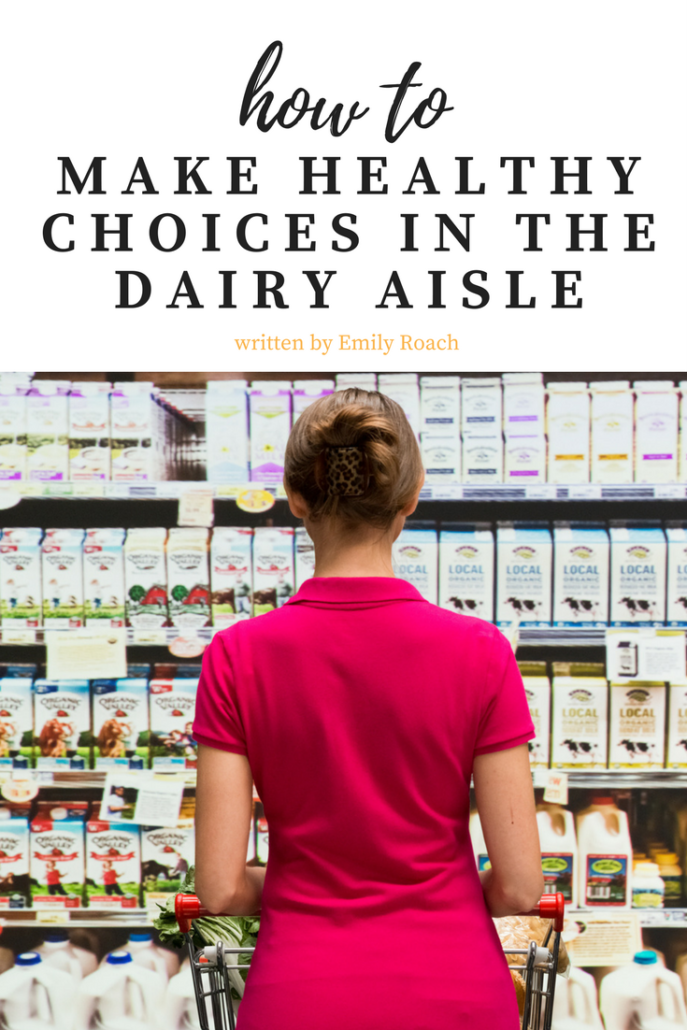
Healthy Dairy Options Additional resources
The Big Fat Surprise: discusses the need for fat in our diet.
Devil in the Milk: Illness, Health and Politics of A1 and A2 milk. : further reading to learn about the various qualities of milk
The Paleo Approach: in depth look at why eliminating dairy can lead to optimal health, especially for women with autoimmune conditions.
Click here for a report card on your favorite organic milks to see how they stack up to the competition. There is also a yogurt one on this site too. I learned that Organic Valley is a better option than Horizon. Horizon is organic, but it’s mass produced and the nutrient quality is not the same as using milk from grass-fed animals. Their cows may be getting organic grain feed, which isn’t going to produce a premium product.
Sources
- The Paleo Approach, pg 106
- Feskanich, D., W. C. Willett, M. J. Stampfer, and G. A. Colditz. “Milk, Dietary Calcium, and Bone Fractures in Women: A 12-year Prospective Study.” American Journal of Public Health. U.S. National Library of Medicine, June 1997. Web. 06 Apr. 2017.
- Roig, M.j., A. AlegrıÌa, R. Barberá, R. Farré, and M.j. Lagarda. “Calcium Dialysability as an Estimation of Bioavailability in Human Milk, Cow Milk and Infant Formulas.” Food Chemistry 64.3 (1999): 403-09. Web.
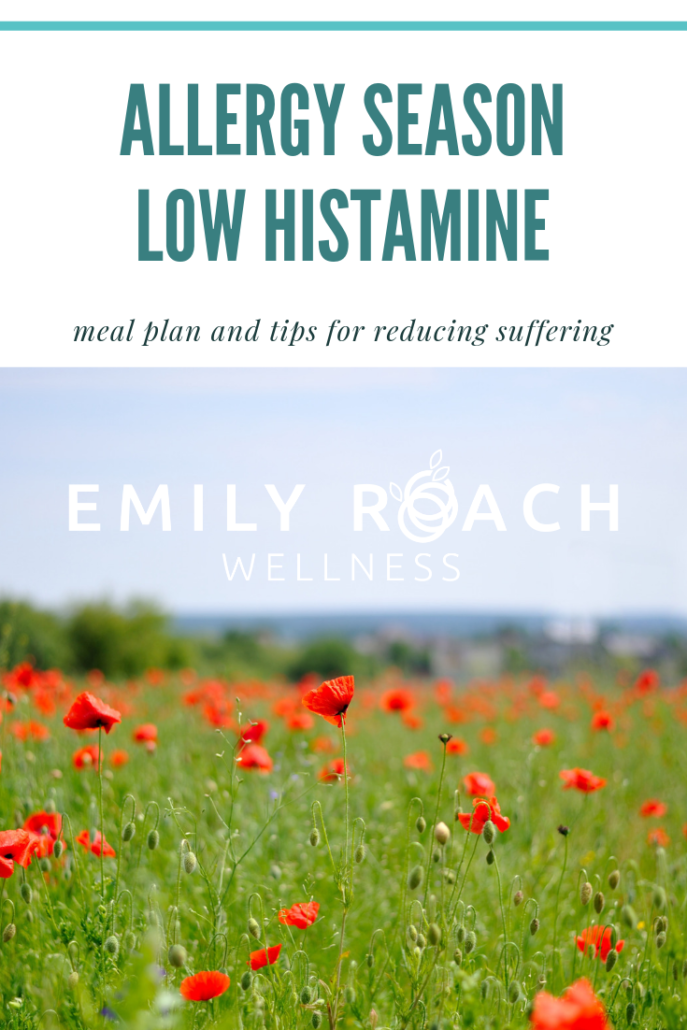
Can a low histamine diet help your seasonal allergies? Do your allergies flare up in the spring? Below is an allergy season meal plan, which follows the protocol of a low histamine diet.
Your food choices can help alleviate, or aggravate, allergy symptoms. Histamine is part of our natural immune response. When our body detects something foreign in our body, like pollen, histamine is released to “attack” it. Sometimes our body is too aggressive with the histamine release and then you end up with itchy eyes, runny nose, and sneezes for days.
I had the worst seasonal allergies and it wasn’t until I switched to a gluten-free, dairy-free lifestyle that I found relief without a prescription. Both gluten and dairy can cause chronic inflammation in your body. By removing these two triggers, your body is less likely to overproduce histamine when it’s allergy season. Pair this with a low histamine diet plan and you will set yourself up for fewer sniffles and sneezes!
There are a few other key things to do during allergy season to complement the meal plan below.
-
Boost your immune system with foods rich in vitamin C and polyphenols.
-
Use locally grown raw honey repeatedly in the weeks prior to allergy season to prep your body for local pollen.
-
Increase your intake of fresh herbs, like mint, cilantro, and watercress. All of these increase your levels of quercetin, a natural antihistamine.
-
Focus on fresh food first (meat, produce.)
-
Avoid cultured, processed, cured, fermented, and aged foods. (cheese, beer, wine, beef jerky, and smoked meats.)
-
Avoid soy sauce, Worcestershire sauce, and yeast extract.
RELATED: Do you have Histamine Intolerance?
Allergy Season Meal Plan
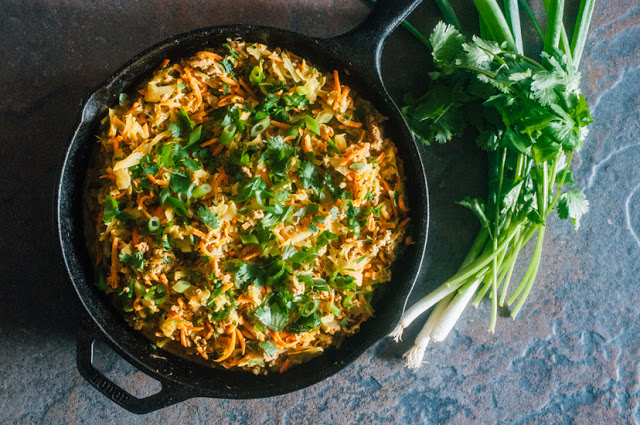
Dinner
Turmeric Pork Skillet from Sweet Treats. This dish is anti-inflammatory, AIP, paleo, and Whole30 compliant.
Chicken Lemon Spinach Stew from A Healthy Life for Me. Adding lemon to chicken soup is a game-changer. Plus it adds a healthy dose of Vitamin C!
Master Cleanse Salad Recipe from Detox DIY. Includes watercress and immune-boosting broccoli. Pair with chicken or hard-boiled eggs as a protein source.
Cilantro Lime Chicken with Avocado Salsa from Joyful Healthy Eats. Cilantro is a great herb for our allergy season meal plan, plus it helps detox heavy metals found in your body. (limit the avocado as it is higher in histamine.)
One Pan Roasted Pork with Sweet Potato, Pear, Apple, and Garlic from Garlic Matters.
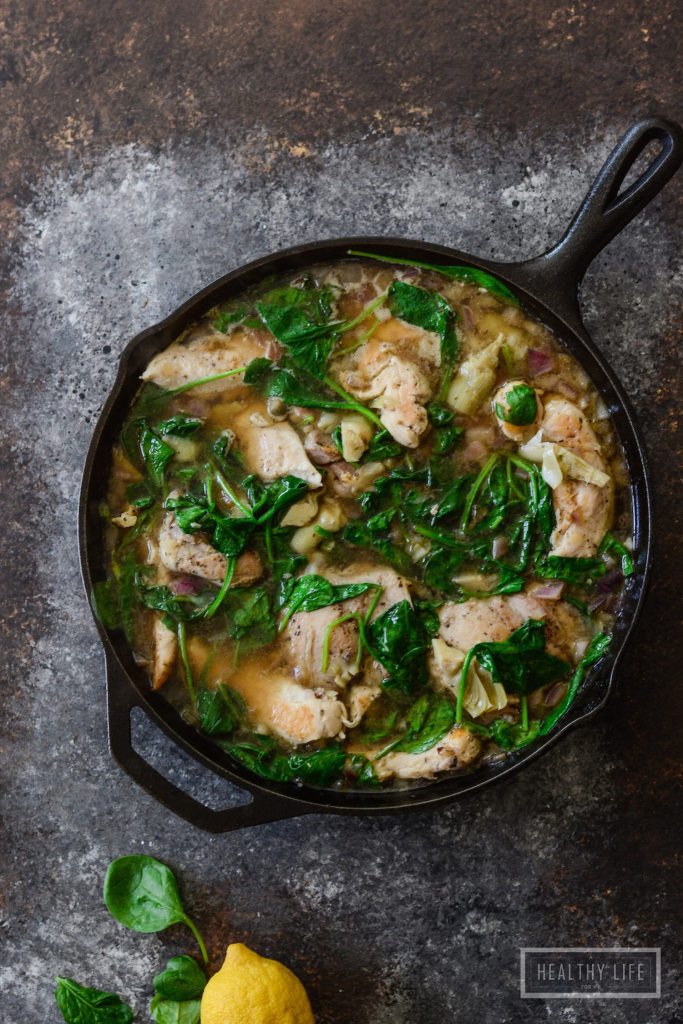
Lunch
Easy Almond Apple Quinoa Salad-from Chelsea’s Messy Apron. Apples also produce quercetin, a natural antihistamine. Note, avoid store-bought chicken stock as it often contains yeast extract, another form of MSG. Instead, grab the recipe here for homemade chicken bone broth.
Breakfast
Superfood Breakfast Smoothie Bowl from A Glowing Fridge. The spirulina added here is a blue-green algae that is rich in protein and immune-boosting. I use a powder like this one.
Allergy Season Beverages
Beverages
Green Tea: delivers EGCG, an antioxidant that blocks the production of histamine and immunoglobulin E.
Bone broth: reduces inflammation. Learn more about why I drink bone broth every morning.
Bonus
Probiotics: a dose at night can help boost your immune system during the height of allergy season. Always buy probiotics from a quality source. However, only certain strains of probiotics should be used if you have histamine intolerance (HIT).

Additional Resources
Do you have a Food Sensitivity or Food Allergy?
Healing Histamine (low histamine food list, great for anyone with histamine intolerance)
I hope you learned something new with this allergy season meal plan, with low-histamine food ideas.

Academy of Culinary Nutrition program
For the past few months, I have been getting an amazing education from The Academy of Culinary Nutrition program, run by Meghan Telpner. I was challenged with new recipes in the kitchen, pushed to my limits writing research papers while taking care of three little ones, and am inspired by the community I am now a part of as an alumni. Let me tell a little more with my review of the Academy of Culinary Nutrition.
Last winter, I started feeling a little lost. Maybe it was a result of living in a foreign country without my friends and family nearby. Maybe it was looking ahead to September and realizing my kids would be in school all day together in a Montessori program. Did I want to be a full time blogger? No, my heart wasn’t there. I knew I needed something more. That’s when it hit me.
Nutrition.
I can talk about real food and nutrition all day long, but I never received any credentials around my love for healthy living. The idea of health coaching clicked and I started doing my research. For a month, I talked with multiple health coaching programs and chatted with a friend who has a successful life coaching practice. I learned a lot about the quality of different programs, and also the lack of regulation when it comes to being “certified.”
Then I found The Academy of Culinary Nutrition.

When I learned Meghan was based in Toronto, it felt like a sign. I’m only here for two years and this amazing program is in my backyard, yet is online and available from anywhere in the world. It would offer me flexibility as I traveled in the fall and still be able to access the program. I read everything I could about the program, listened to the webinar (and took a lot of notes!), had Jim watch the video about making almond milk, and I was hooked.
The Academy of Culinary Nutrition program is for people like me who wanted a solid nutrition education, and then I added on an optional business component. There’s also an honorary level for the program for anyone who wants the information for personal use. I signed up last spring and for the next few months, I couldn’t wait to get started on this new journey.
Over the summer I started doing some of my required reading, including Meghan’s Undiet book. It gave me a great foundation for understanding the philosophy of the class. In September, I was ready to get going and get my hands dirty in the kitchen.
Not only did I get my hands dirty, but I trashed my kitchen a few times. There were some marathon cooking days when I had recipe assignments due, a family to feed, and just a mountain of dishes to tackle. I only wish I could have had a house elf to do dishes for me during this course!

A peek at one of the recipes for a homework assignment.
On those cooking days, I used ingredients I had always passed by at the store. Nori rolls, seaweed, gelatin, and horseradish root. I always considered myself a “foodie” but I truly didn’t understand how powerful food is for our health.
Academy of Culinary Nutrition Success Story
The #1 thing I came out with from this class is how important it is for us to take care of our health and let ourselves feel amazing. I have followed a gluten-free, dairy-free lifestyle during the course and am continuing this path. Why? Because I feel better. I have more energy. I no longer feel wiped out late in the day as I’m trying to get dinner on the table. Plus, the skills I learned in the class has helped me learn how to do this without getting stressed out about planning my meals.
Did I mention I had homework each week? That would also be why I couldn’t get a blog post up the past few months. I love writing, but not sitting at a computer. I reached my typing limit during this course, but look forward to sharing some of my new recipe creations here in the coming weeks.
What you learn in the Academy of Culinary Nutrition program
I worked on creating custom meal plans for clients that help with digestive issues. I came up with a protocol for managing thyroid conditions. Armed with books about natural medicine and knowledge from hours of lectures from the course has given me the culinary nutrition education I was looking for. Here’s a recap of all the skills taught in the Academy of Culinary Nutrition program:
[one-third-first]
• A thorough understanding of the impact food choices have on health and specific health conditions.
• The development of meal plans in accordance with various dietary restrictions.
• Recipe modification and testing.
[/one-third-first]
[one-third]
• Recipe development and testing.
• Experience with a client simulation: following a prescribed meal plan for 3-7 days
• Selection of specific healing ingredients, experimentation with a variety of applications, and the creation of recipes that exploit health promoting benefits.
[/one-third]
[one-third]
• Successful hosting of a cooking class /workshop.
• Knowledge in and experience with local food community.
• The study and development of food philosophy.
[/one-third]
Now it’s my job to help share this message by working with clients to help them learn how to bring real food back to their life. Need a custom meal plan? I can help. You can learn more about my nutrition consulting services here. And a big thank you for being a part of my community here via the blog. It’s been over seven years and I can’t wait to see what the next seven holds.
One more thank you to my children and husband, who tried everything I put on the table. Thank you for being so supportive.
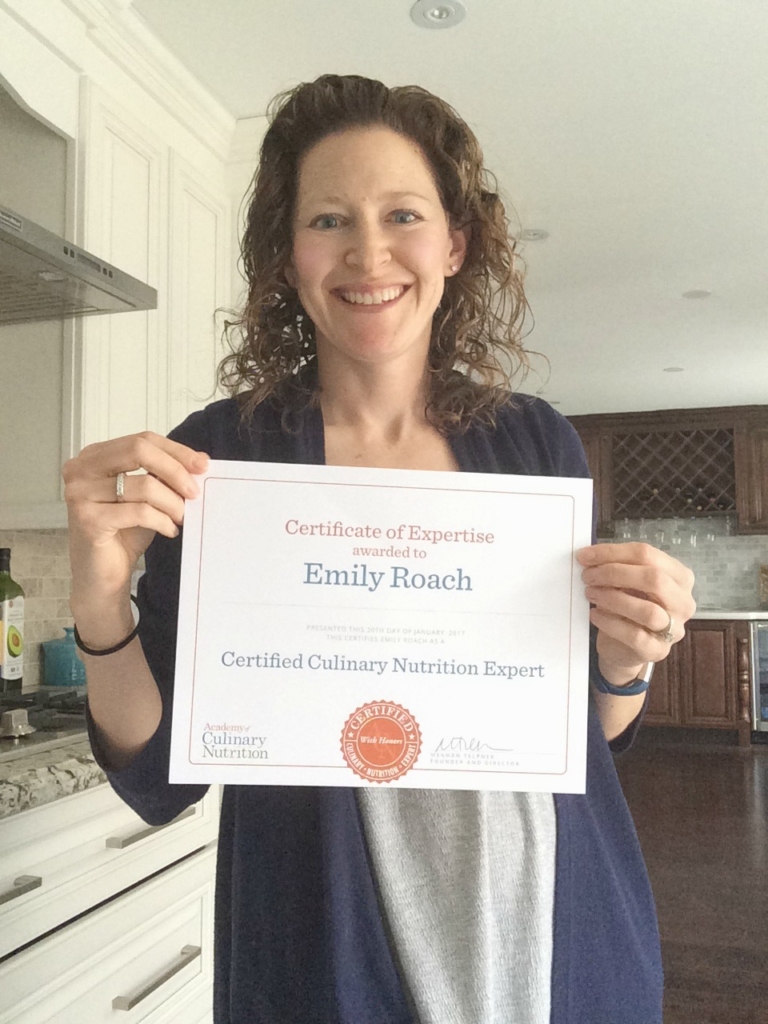
I cannot speak more highly of The Academy of Culinary Nutrition program. Meghan, her team, and the culinary nutrition expert community were all so supportive during this journey. Head over the the school site, and get on the mailing list to learn more about the community. If any has questions for me about the program, or my services, feel free to reach out to me at hello@emilyroachwellness.com. I’m happy to listen and share more about my review of the Academy of Culinary Nutrition program.
Free Meal Plan
Sitemap
SEARCH
